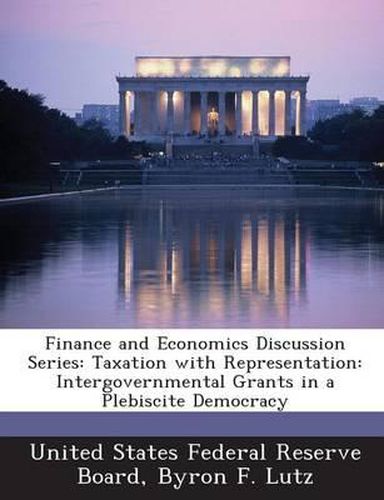Readings Newsletter
Become a Readings Member to make your shopping experience even easier.
Sign in or sign up for free!
You’re not far away from qualifying for FREE standard shipping within Australia
You’ve qualified for FREE standard shipping within Australia
The cart is loading…






Economic theory predicts that unconditional intergovernmental grant income and private income are perfectly fungible. Despite this prediction, the literature on fiscal federalism documents that grant and private income are empirically non-equivalent. A large scale school finance reform in New Hampshire–the typical school district experienced a 200 percent increase in grant income–provides an unusually compelling test of the equivalence prediction. Most theoretical explanations for non-equivalence focus on mechanisms which produce public good provision levels which differ from the decisive voter’s preferences. New Hampshire determines local public goods provision via a form of direct democracy–a setting which rules out these explanations. In contrast to the general support in the literature for non-equivalence, the empirical estimates in this paper suggest that approximately 92 cents per grant dollar are spent on tax reduction. These results not only document that equivalence holds in a setting with a strong presumption that public good provision decisions reflect the preferences of voters, but also directly confirm the prediction of the seminal work of Bradford and Oates (1971) that lump-sum grant income is equivalent to a tax reduction. In addition, the paper presents theoretical arguments that grant income capitalization and heterogeneity in the marginal propensity to spend on public goods may generate spurious rejections of the equivalence prediction. The heterogeneity argument is confirmed empirically. Specifically, the results indicate that lower income communities spend more of the grant income on education than wealthier communities, a finding interpreted as revealing that the Engel curve for education is concave.
$9.00 standard shipping within Australia
FREE standard shipping within Australia for orders over $100.00
Express & International shipping calculated at checkout
Economic theory predicts that unconditional intergovernmental grant income and private income are perfectly fungible. Despite this prediction, the literature on fiscal federalism documents that grant and private income are empirically non-equivalent. A large scale school finance reform in New Hampshire–the typical school district experienced a 200 percent increase in grant income–provides an unusually compelling test of the equivalence prediction. Most theoretical explanations for non-equivalence focus on mechanisms which produce public good provision levels which differ from the decisive voter’s preferences. New Hampshire determines local public goods provision via a form of direct democracy–a setting which rules out these explanations. In contrast to the general support in the literature for non-equivalence, the empirical estimates in this paper suggest that approximately 92 cents per grant dollar are spent on tax reduction. These results not only document that equivalence holds in a setting with a strong presumption that public good provision decisions reflect the preferences of voters, but also directly confirm the prediction of the seminal work of Bradford and Oates (1971) that lump-sum grant income is equivalent to a tax reduction. In addition, the paper presents theoretical arguments that grant income capitalization and heterogeneity in the marginal propensity to spend on public goods may generate spurious rejections of the equivalence prediction. The heterogeneity argument is confirmed empirically. Specifically, the results indicate that lower income communities spend more of the grant income on education than wealthier communities, a finding interpreted as revealing that the Engel curve for education is concave.